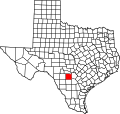| Medina River Río Mariano, Río San Jose, Río de Bagres | |
|---|---|
 Medina River near Bandera, Texas | |
 Map of the Medina River watershed | |
| Location | |
| Country | United States |
| State | Texas |
| Physical characteristics | |
| Source | |
| • location | near Medina, Bandera County, Texas |
| • coordinates | 29°47′46″N99°15′19″W / 29.79611°N 99.25528°W [1] |
| Mouth | San Antonio River |
• location | Bexar County, Texas |
• coordinates | 29°14′04″N98°24′28″W / 29.23444°N 98.40778°W [1] |
• elevation | 128 m (420 ft) |
| Basin features | |
| River system | Guadalupe River |
The Medina River is located in south central Texas, United States, in the Medina Valley. It was also known as the Rio Mariano, Rio San Jose, or Rio de Bagres (Catfish river). Its source is in springs in the Edwards Plateau in northwest Bandera County, Texas, and it merges with the San Antonio River in southern Bexar County, Texas, for a course of 120 miles. It contains the Medina Dam in NE Medina County, Texas which restrains Lake Medina. Much of its course is owned and operated by the Bexar-Medina-Atascosa Water District to provide irrigation services to farmers and ranchers.
